Checklists, Gantt Charts, and Kanban Boards – Organize Your Tasks
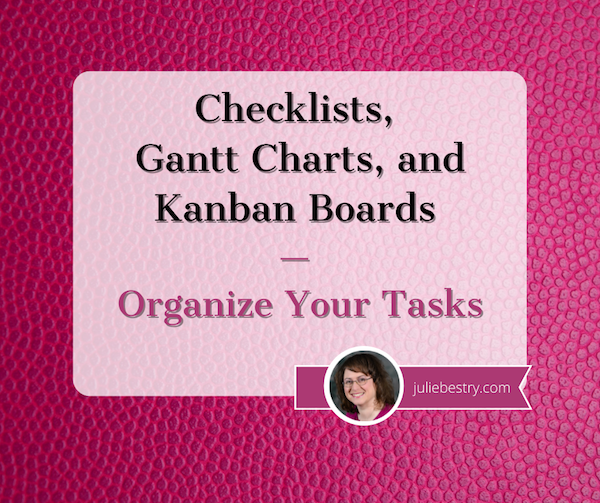
Let’s talk about tasks.
How do you keep track of what you have to do? How do you make sure you’re doing the “right” things, the ones that are your highest priorities? How do you keep yourself from getting stressed out by everything waiting to get done?
Beyond your own progress and productivity, how do you make sure your team (whether that’s your department or committee at work, or TeamFamily) is being efficient, getting the right things done, and not duplicating efforts?
There are a wide variety of methods (originally created in analog formats, later adapted to the digital world) to collect your “aspirations” (things you want to do or should do) and track progress. The most common method of noting what you need to do (so that you don’t forget it) and monitoring what you have completed, is a checklist, but we’re also going to look at two other types of tools for keeping on top of your tasks and projects.
CHECKLISTS
The most basic type of checklist is a “to-do” list. You write down what you have to do — and hopefully, you do it. (Motivation is beyond the scope of today’s post, but feel free to check out Count on Accountability: 5 Productivity Support Solutions and Flow and Faux (Accountability): Productivity, Focus, and Alex Trebek to address ways to get from knowing what you intend to do to actually achieving it.)
If you only have a few items, and you don’t have to worry about the order in which tasks are accomplished or who is getting what done, a to-do list is fine. If you have three or four tasks (say, two errands, a phone call, and a package to box up and mail), you can even get away without checking off the completed items. For our purposes, we’ll even leave aside the debate over checking things off vs. crossing them out. We’ll leave that for a future post! (But Paper Doll is Team Check-It-Off.)
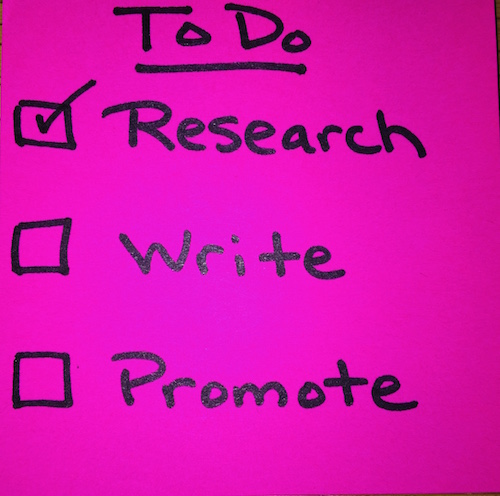
Of course, there are more intricate checklists. In Dr. Atul Gawande’s book The Checklist Manifesto, he wrote about the power of a checklist to combat the problems that arise from the sheer (growing) complexity and volume of human knowledge and our efforts to strive to be better, build bigger, and live more boldly. No matter how much specialized training we have and how we use technology to support our efforts, things go awry. Tiny steps get missed.
But the humble checklist can be the solution. In Gawande’s book, he looked at how mistakes in the operating room (contributing to both mortality and morbidity) have dramatically declined since the institution of the World Health Organization’s Surgical Safety Checklist in many countries.
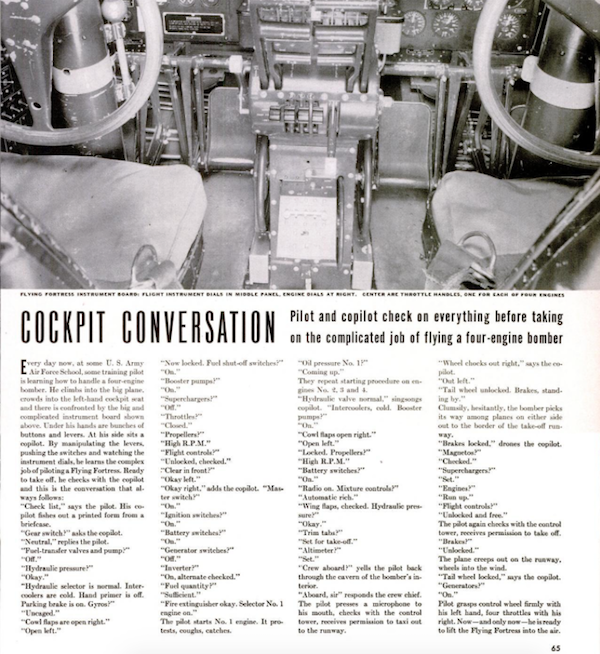
©1942 Life Magazine, August 24
Since 1935, airline pilots have developed and used pre-flight checklists to ascertain that the maintenance and on-deck crews have accomplished all tasks, in the proper order, before takeoff.
Almost all manufacturers have training manuals with checklists delineating proper safety and other precautions for smooth production efforts. In the construction field, they’re called punch lists, and they ensure that the architect, the contractor, the sub-contractors, and even the building owner complete all of the dependent and interdependent tasks so that everyone can finish the job efficiently and safely.
Checklists can be analog (paper) or digital (anything from a document on your computer or in the cloud to a desktop or mobile app).
The appeal of analog is that it’s familiar. You pull out a piece of paper and start listing all of the things you need to get done. Voila. For greater granularity, you can develop sub-lists to improve your productivity. For example:
1) Group all of the tasks that involve errands in one list, then visualize where you’ll have to drive, and develop a sequence so that you travel the fewest total miles.
For example, if you had six errands, you could zig-zag from one to the other, or you could plan a route that would take you to the farthest location first and then complete more tasks as you travel back toward home.
There are even apps that will optimize the most efficient routes, based on what is commonly known as the Traveling Salesman Problem, without you having to do all that math!
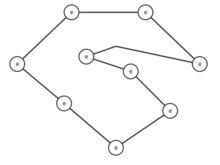
Most are designed for delivery companies rather than personal errand runners (and are priced for them, too), but there are a few worth checking out to amp up your out-of-the-house to-do list progress:
- Circuit – free routes for up to 10 stops, then $20/month
- MapZen – really for only the programmers you know, but this article can help
- RouteXL – sadly, it doesn’t integrate with your phone’s GPS, but it is free!
2) Group conceptually related tasks into sub-lists. For example: calls to return, research you have to do, things you have to write. You will improve your productivity if you can get into a flow state, focusing on what task type.
3) Prioritize tasks in your lists so that the most time-sensitive are done first. small victories breed success, and if you get the time-pressured tasks completed first, you’ll have more mental energy to focus on the things ones in line.
When you’re analog, you can easily see everything planned for the day or week (or your “life” lists) and you can make changes wherever you are, as long as you have a writing implement and (given that we just came out of a nine-week notebook series) paper. No charging, no waiting for something to power up, no waiting while an app updating.
Of course, analog lists have a few downsides. The more information you add, the messier your list get. It’s harder to update when plans and priorities change, and then you get a page full of scribbles, and the only way to update to a clean list is to start a new page.
Then again, for some people, that’s the exact appeal of analog; the writing and re-writing of tasks gives you an opportunity to continually reconsider the relative value of tasks in your life. If you’re constantly going to the store to pick up a few grocery items, this frequent review may convince you to upgrade your grocery planning game or even outsource to a delivery service so that you can plan once a week and have food auto-magically appear. (Think: Instacart or Shipt.)
Also, it’s easier to lose an analog list than a digital one. You may prefer your task lists to be created digitally so that, once synced, everything you have to do lives in your phone and computer, going wherever you go. I bet you have at least one task app right now, and perhaps many. One site recently recapped The 82 Best Cross-Platform Tasks Apps of 2021, including their platforms, prices, and whether they support collaboration!
While having your ride-or-die key features may be important, as with most systems, whether it’s notebooks and planners, or software and apps, commitment to one system is generally the biggest signifier of success. Some of the most popular task apps for individuals include:
- Remember the Milk – a classic! Free or $20/year for Pro with advanced sorting, sub-tasks, Apple Watch support, and unlimited task sharing
- Teux Deux – free on mobile, $3/month or $24/year
- AnyDo – free, or from $3-$6/month, depending on billing frequency preference
- Things 3 – Apple only and pricey, but it has die-hard fans; $50/Mac, $10/iOS
- Google Tasks – free with your Google account
- Reminders – free, and built into all of your MacOS and iOS devices)
- Habitica – if gamifying your tasks might give you a little more motivation
If you’ve got a team, and you’re looking for serious project management rather than task lists, you might consider:
- Asana – free for individuals and small teams, $11/user/month for Premium, and $25/user/mnth for companies. Asana is a full-on project management tool.
- Basecamp – the limited personal version is free; for businesses, it’s a flat $99/month
- Trello – free for individuals and small teams, $10/user/month for teams up to 100 users. (Trello is a stellar tool and, in my opinion, much more user-friendly than the other options. More on Trello later.)
GANTT CHARTS
If you’re working through a repeated project, one that generally has the same set of steps performed each time (whether it’s prepping for a vacation, on-boarding new employees, or migrating to a new cell phone), a checklist will give you confidence that you haven’t missed an essential action.
When you’re the only one performing the tasks, and each step is fairly distinct and short-lived, a checklist is enough. But when you’re dealing with multiple projects (each of which have multiple dependent tasks), especially when your whole team is involved, project management devotees find that a Gantt chart is useful.
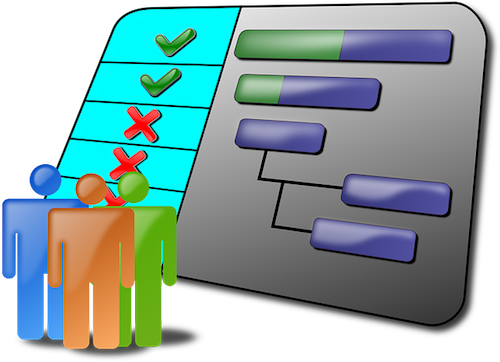
Gantt Chart Image by OpenClipart-Vectors from Pixabay
A Gantt chart is basically just a horizontal bar chart showing the timeline of a project. It’s one way to visualize the project schedule so that you can track the work as it’s getting done (or, not getting done) and noting the key milestones as you as your team hits them.
Each horizontal bar represents a task or element of the project, and however long the bar extends represents how long the task will (or should) take. Think the bars on a Gantt chart like how your cable TV menu shows the programs on individual, horizontal lines, one line per network, and how a sit-com takes up a short time range, a one-hour drama takes up twice as much space, a movie extends even further, and a football game extends off the screen and you have to keep scrolling.
Color-coding identifies which person or team is responsible for each task, and you can use symbols to identify dependent tasks.
While a checklist clarifies what needs to be done and tracking can be updated with a simple checkmark, it’s not very refined. A Gantt chart offers some distinct advantages. You can:
Get clarity – The Gantt chart requires that you have a project plan in place and that you develop a timeline to accomplish everything. A checklist starts as a brain dump of all related ideas, and then may morph into something orderly if precision is required. But a Gantt chart requires precision at the outset – what tasks will be done? By whom? In what order? Started when? Completed when? Which elements are dependent upon other elements being completed?
See time – With a Gantt chart, you are going to estimate timelines with the knowledge that while some things may be completed earlier than expected, other stages will take longer. As necessary, you can update and lengthen the bar for applicable stages. If only the cable TV on-screen guide would update, in real time, when a sporting event ran long so you wouldn’t have to keep checking to see if your show was ready to start!
Each adjustment gives you the opportunity to evaluate potential changes to your process. Will you have to delay your project launch? Or might you authorize overtime or bring in people from other departments (or outsource) to deliver the project on-schedule. Visualizing time in, well, real time, means you know if you need more (human or financial) resources.
Give everyone the big-picture view – The more people are involved, the harder it is to see what’s going on with other teams. A Gantt chart offers perspective and serves as a real-time status report without need for a meeting that could have been an email, or an email that could have been “Just look at the Gantt chart!” With the chart, you know when it’s about to be your turn start, and to deliver, your part of the project.
A Gantt chart offers perspective and serves as a real-time status report without need for a meeting that could have been an email, or an email that could have been *Just look at the Gantt chart!* Share on XGantt charts have some downsides. It takes a while to set them up, and you really need to develop them digitally, as anything beyond the most simple kind will get messy on a whiteboard.
You can create free Gantt charts from templates online or in software you may already be using:
- Google Docs – free, and you probably already have a Google account
- Microsoft Excel, Word, and PowerPoint – if you work in an office, you probably already have these
- Timeline by Asana – especially advantageous if your team is already using Asana
- Airtable – which has the advantage of being pretty (and check out the video below for an in-depth look at Gantt charts in general, as well as Airtable’s approach)
- Agantty – check out the company’s YouTube page for lots of helpful tutorials
- Canva (another pretty option, with lots of templates and customization options, but less easily updatable than the spreadsheet-based options)
There are also web-based software options specifically designed for developing Gantt charts, available at varying price points, including:
- Toggl (free for solo users; $8/user/month for teams, and $13.35/user/month for businesses)
- SmartSheet ($14/user/month for individuals, $25/user/month for businesses)
- ProjectManager.com (free for up to three users; $14.user/month for teams, $25/user/month for large businesses)
- Clickup (a visually appealing solution, with a free level and an inexpensive ($5/month) unlimited option)
- GanttPro ($15/user/month for individuals, $8.90/user/month for teams)
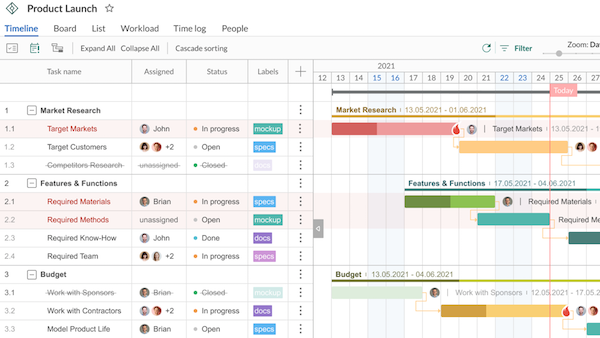
A checklist is simple. A Gantt chart is more complex, but streamlined and visual. Alas, neither is very inspiring. Luckily, there’s a tool that mixes the elements of both to provide visual motivation for your productivity.
KANBAN BOARDS
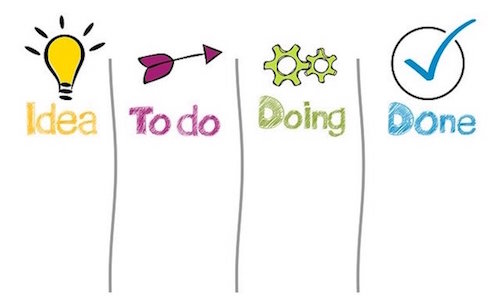
Image by Gerd Altmann from Pixabay
One of the most increasingly popular ways to track tasks is through the use of tasks boards, often known as Kanban boards. Kanban is the Japanese word for “billboard,” and I think a Kanban board can serve as a billboard, advertising and promoting your tasks to you.
Kanban is the Japanese word for 'billboard' and I think a Kanban board can serve as a billboard, advertising and promoting your tasks to you. Share on XKanban boards come out of the Japanese lean manufacturing process, but all you really need to know is how to make a simple one to work for you:
- A Kanban board has columns, sometimes described as “swimlanes,” to help you visualize each element of your efforts at various stages in the process.
- Cards, sticky notes, or icons depicting the task move, from left-to-right, through the stages represented in those columns or swimlanes. This lets you (and your team members, if applicable) see where each task falls in the progress toward completion.
- At minimum, there are three columns: To Do, Doing, and Done. If you prefer, say Pending, In-Progress, and Completed. (But it’s so much fun to move it to the right-most column and shout, “Done!!!”
- In the To Do column, set up all of your brainstormed tasks from that brain dump, just waiting to move forward. There can be a melange, or you can group them by task type.
- When you start working on a task, move it to the Doing column. And, as you’ve probably guessed, once you’ve finished, it can move to the Done column.
Unlike a to-do list, you can see your status and feel motivated. Unlike a Gantt chart, it doesn’t feel so formal!
And you can absolutely make your own Kanban boards. Obviously, this has diminishing returns the larger your group is, but it’s great for you on your own, for your family, or for your small group (dorm suitemates, colleagues in the same office, etc.)
If you want a visual representation of what you (and maybe your family or team) needs to do, you can be as low-rent or as happily crafty and DIY as you prefer.
Me? I’m all about low-effort. If there’s no whiteboard in the space where my client and I are working, I’ll use two vertical strips of blue painter’s tape on the wall and a stack of multi-colored Post-It® notes. Instead of a massive list of tasks that creates a sense of overwhelm, we:
- Put each task on a sticky note.
- categorize tasks types by color – perhaps phonecalls in blue, things to write in red, bills to pay or invoices to send in green
- Select the highest priority task(s) to put in the middle column. Get working!
You may wonder how you can be “doing” more than one task at a time, but the Kanban/task board works best looking at day-by-day progress. If you call the doctor’s office to make an appointment but have to leave a message, leave it in the “doing” column until the doctor’s office calls back and you’ve scheduled the appointment. If you’re writing a document but have to pause while you wait for some data to come in, for today at least, it stays in the doing column. Of course, if a task stays in “doing” more than a few days without any forward momentum, you’ll need to reconsider.
You can take a photo of your board and share it with team members via Dropbox, Evernote, GoogleDrive, etc. Post-it® even makes its own app for scanning, capturing, and sharing! (See what Post-it® has to say about Kanban boards!)
No painter’s tape? Try party streamers.
No wall space? No white board? How about a window or a mirror? Be creative and think vertically.
If you prefer something a little more artistic, office supply giant Quill has put together a nifty infographic on creating a task (AKA: Kanban) board.
If you want to DIY your own digital Kanban board, make a few columns in a spreadsheet like Excel or Google Sheets. Label the top row with column headers for To Do, Doing, and Done. As you work on a task, cut it from the first column and paste it into the second. When you finish a task, cut it from the second column to the third.
But really, if you’re going to go digital, pick one of the Kanban-making apps. The bright colors, drag-and-drop features, and advanced resources will make it worth your while.
- Trello – There’s so much built-in automation, I can’t think of a better place to start. (There’s a lot more you can do, as this video shows, but Trello was created to make Kanban can-do!
There are so many sites getting into the Kanban game, that rather than list other apps, I’ll just point you to some recent round-ups:
- 17 Best Kanban Apps to Improve Workflow
- 8 Terrific Trello Alternatives in 2021
- Best Kanban Software of 2021
The big advantage of a Kanban board is that you (and everyone else) can see it and stay motivated. In your house or office, when the Kanban board is on the wall, it’s a great billboard.
But what if you have 15 people on your team, spread across five cities and two continents? Your Kanban may be in Google Drive or iCloud or in the dedicated software, but I find that things that “live” in your computer or phone just don’t have the same immediacy as brightly colored sticky notes on your wall.
Or do they? What do you think?
Checklists, Gantt charts, and Kanban boards: what do you use for yourself? What would you like best for your team? I look forward to seeing which techniques and which apps have caught your eye.





Big fan of Kanban and checklists, and Gantt charts sound intriguing. Both Kanban and Gantt really appeal to my visual side, although there’s an ingrained pleasure in crossing off a list item (green highlighter) which will be hard to let go of. But I’m going to explore the Gantt because I’m always looking for a way to see the big picture of a project on one page.
Lucy, I think there are situations in which all can be useful. I can see having a checklist for procedures, a to-do list for personal items, a Kanban board for seeing work tasks move through stages, and a Gantt chart for the entire team. I think in words rather than pictures, but I see clients really light up with improved productivity through Kanban boards. It’s all good!
I no longer have a level of complexity that requires a Gantt chart, but I remember learning about them in business school. We also used the term “PERT chart.” I know people who are overseeing extremely complex and detailed projects, and these kinds of tools are a must. They really do help, especially when they are online for large teams. Everyone knows what is going on. On the personal level, I’ve seen a lot of people having success with bullet journaling as a way to achieve more detail than a simple checklist. An especially nice option for the creative/artistic type.
Good points, Seana. I considered talking about bullet journals under the checklists section, but (as always) my post was so long! I wish I could get into bullet journaling, at least to experience it more fully, but for most of my tasks, I assign them (to myself) and complete them within a day, or the week, at most, depending on the length of the task (or complexity of the project). I know I wouldn’t be a Gantt person, but they’re popular in a lot of fields with “deliverables.” (Oh, buzzwords!) I didn’t know PERT, so now I’ll go off and read more! Thanks for reading!
I can’t resist a post about charts, in any form! My own current task board is in the form of four reusable 4X4 “stickies” on the filing cabinet in my office (which is also open to the kitchen and dining room). Each one is a category (Home, Work, Self, Others) and holds ONE thing I need to do in that category that day. If I finish them, and feel like doing more, I can. I love the Ganntt chart comparison to TV schedules! And I’ve been known to tape 8.5X11 sheets of paper to my french door window panes (in my office) as a way of doing a mind dump (by category, or Today/Sooner/Later) or planning a project.
I’m so glad you got my TV schedule description. I should have thought of TV listings in the newspaper, but I’m not sure people get the paper anymore. Or even TV Guide! I love your mind dump method!
I love checklists! So much so I have several on my blog to share with others when I just couldn’t find any good ones that met my needs. Thank you for this thorough post and infographic.
You have great checklists, Sabrina. You’re doing the heavy lifting for your readers!
I recently read another book by Dr. Atul Gawande, Being Mortal, and it was excellent. Will have to look for The Checklist Manifesto!
I haven’t tried Things but I love everything I’ve read about it and it almost makes me want to go Mac! (not happening)
I really like how Dr. Gawande writes, but have not yet read Being Mortal. I’ll take that as a recommendation!
And I get it, because I could never leave Mac for Windows.
I’m a fan of checklists and use them every day. I loved learning about the KanBan charts. I can think of a couple of clients who would just love the painter’s tape and stickie note option. In fact, I’m going to set it up for them when next I see them. I think this idea will really help them move forward with a couple of projects. Thank you very much for this wonderful review!
I didn’t mention it in the post – it was so long already – but maybe I can mention it in another. You can make a mini, portable Kanban board with the tiny 1.5″ x 2″ Post-it Notes and a piece of cardboard (like the kind dry cleaners fold men’s shirts around). To make it pretty, you can use washi table for the column dividers. It’s great for people who want an analog option to be portable for when they work in coffee shops or at the library.
Love the recommendation to consolidate your errands and drive in the order that limits mileage. I do this all the time!
Me, too! I like anything that encourages us to think ABOUT our tasks instead of just thinking of them. More context, more nuance.
Again, a ton of great information. I tend to go “old school”. I write down my 3 Most Important Things on a post-it in the morning. It clarifies for me what I absolutely have to get done. When I feel overwhelmed with tasks I map out my to-dos with post-it notes on a wall in my office, similar to the infographic you showed. I like that! It does help to get things out of my head so I sleep better.
I also have my daily Post-It; I follow the 1-2-3 approach. I pick one big thing, two small/medium tasks, and three mini (“you really need to put that on a list?”) items. But the Kanban is great for when I’m feeling overwhelmed by how much needs to be done. I imagine an Gantt chart would be great for groups/businesses where there are longer-term projects, but when I worked in television, nobody needed to know anyone else’s progress. It was all, “We need it now!!!” and anything else was beside the point. 😉
There are so many great options here. I have workshop participants and clients who ask for recommendations for to- do lists, organizing time etc. This is a terrific source.
My checklists always consisted of to do, to buy, to call.(Easy). Then, when a to-do became a project, I would break it down, like branches of a tree.. The reason I liked to write it out was because putting pen to paper helped me to think it through and come up with the best plan of action. Also, I remember whatever I write down. More so then when I type it or enter it.
Do you have a recommendations for which app is best to plan a wedding? The lists and moving pieces are endless. I know there are some apps out there for wedding planning but I’d like to create my own.
Interesting. A wedding is, as you say, a big project with lots of moving pieces. I’ve heard that professional wedding planners like HoneyBook, but for pure novices needing to cover all the bases, I’ve heard that WeddingHappy does the trick and that WeddingWire is another great down-to-the-basics approach. I haven’t tried any, however.